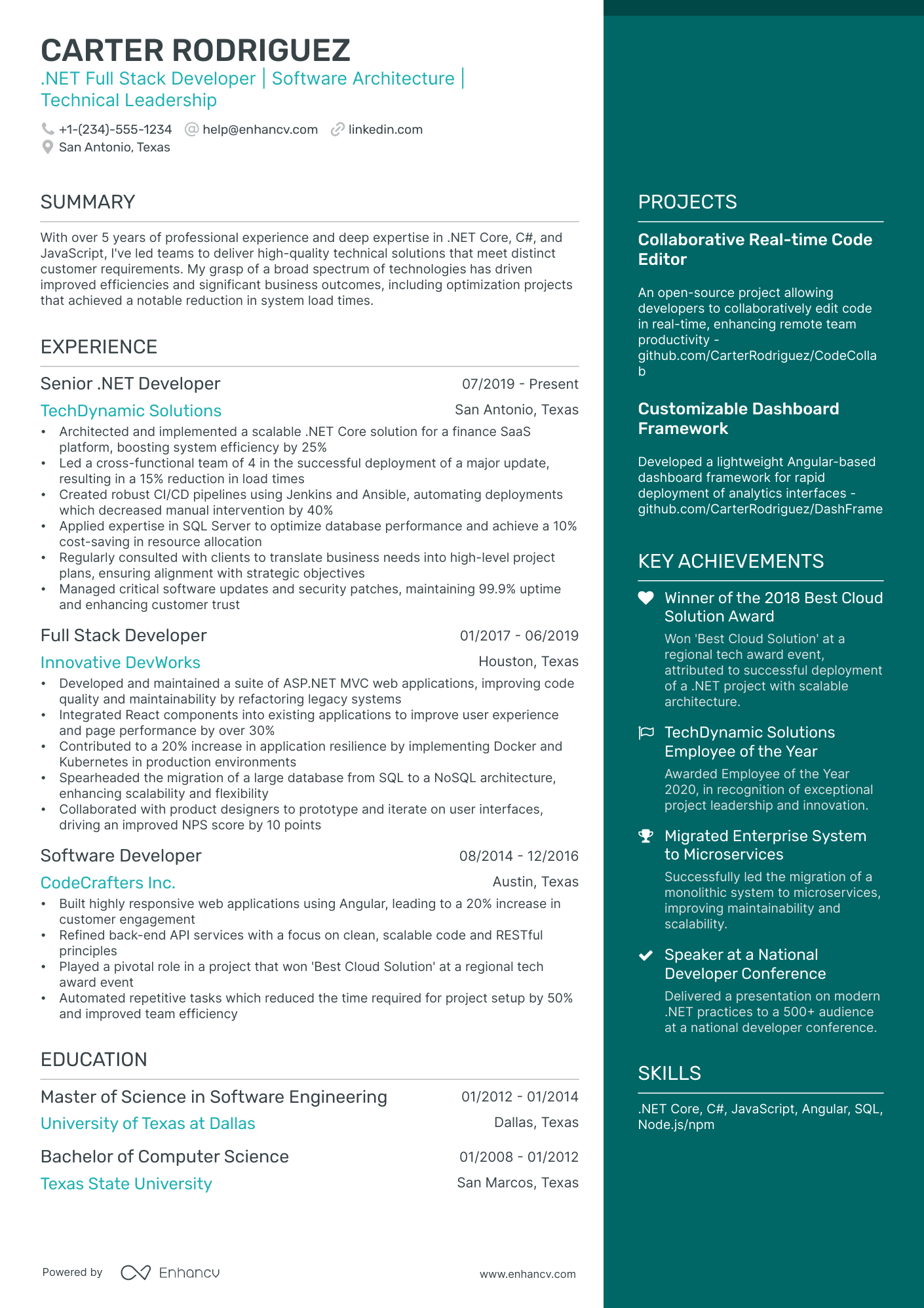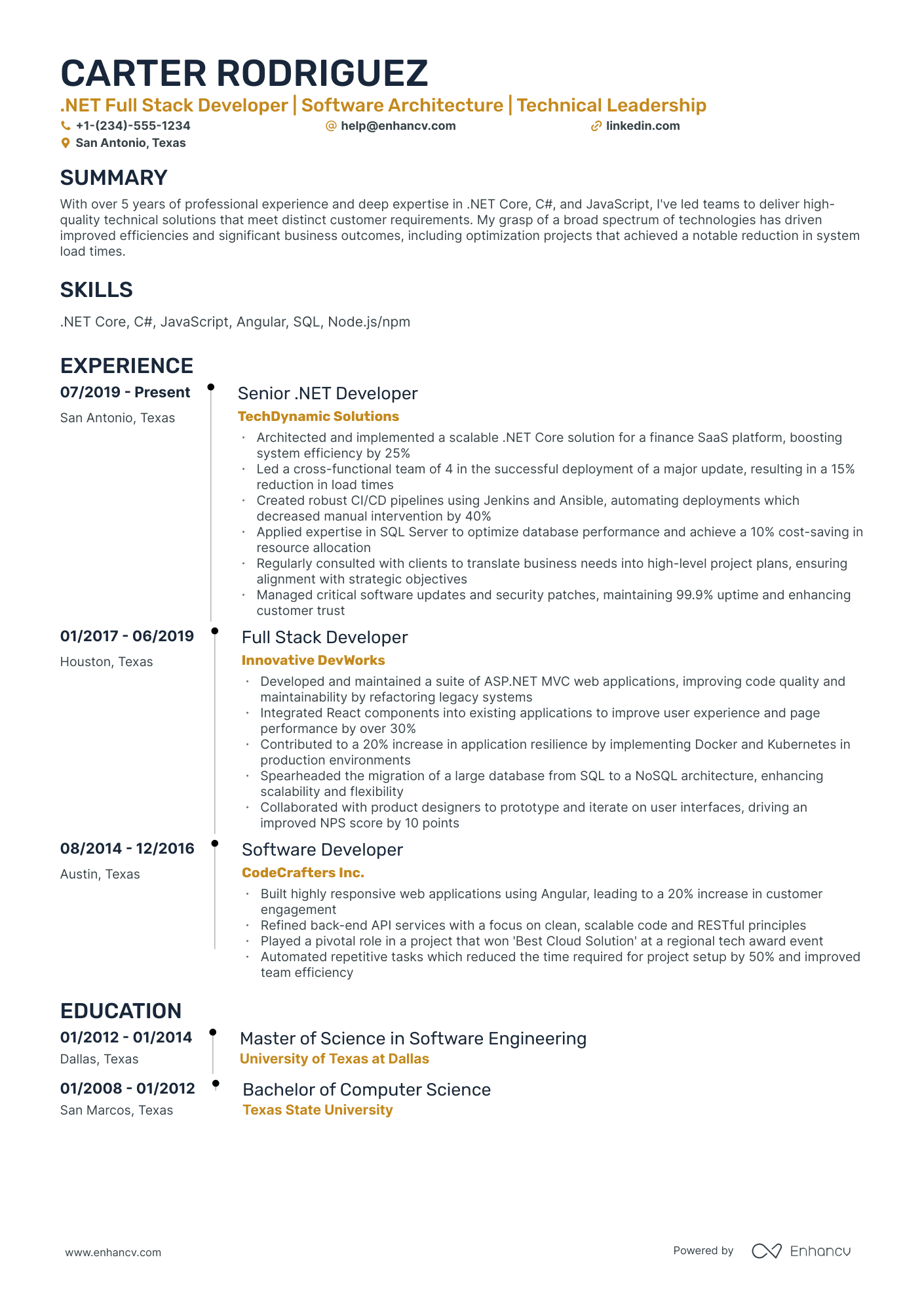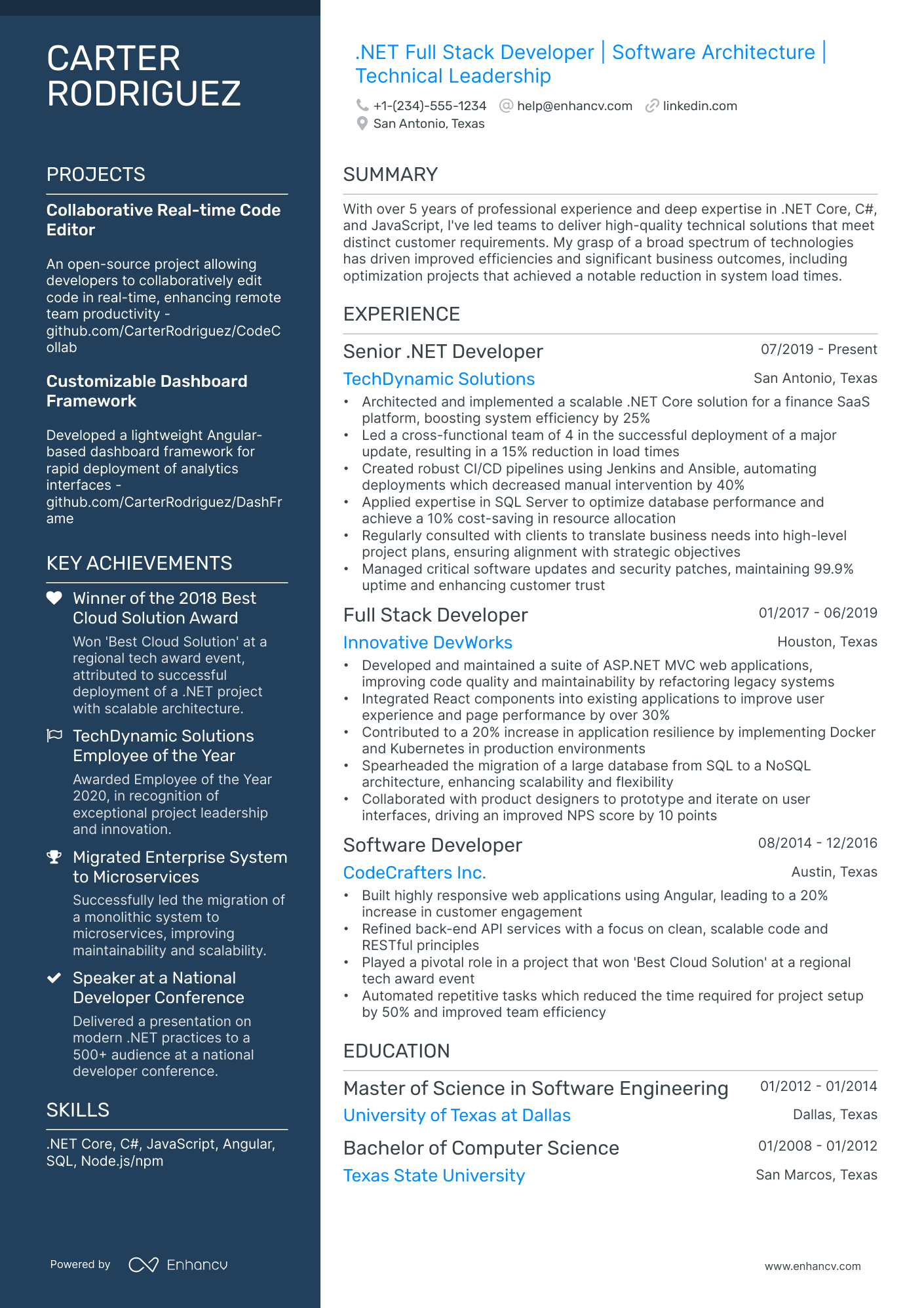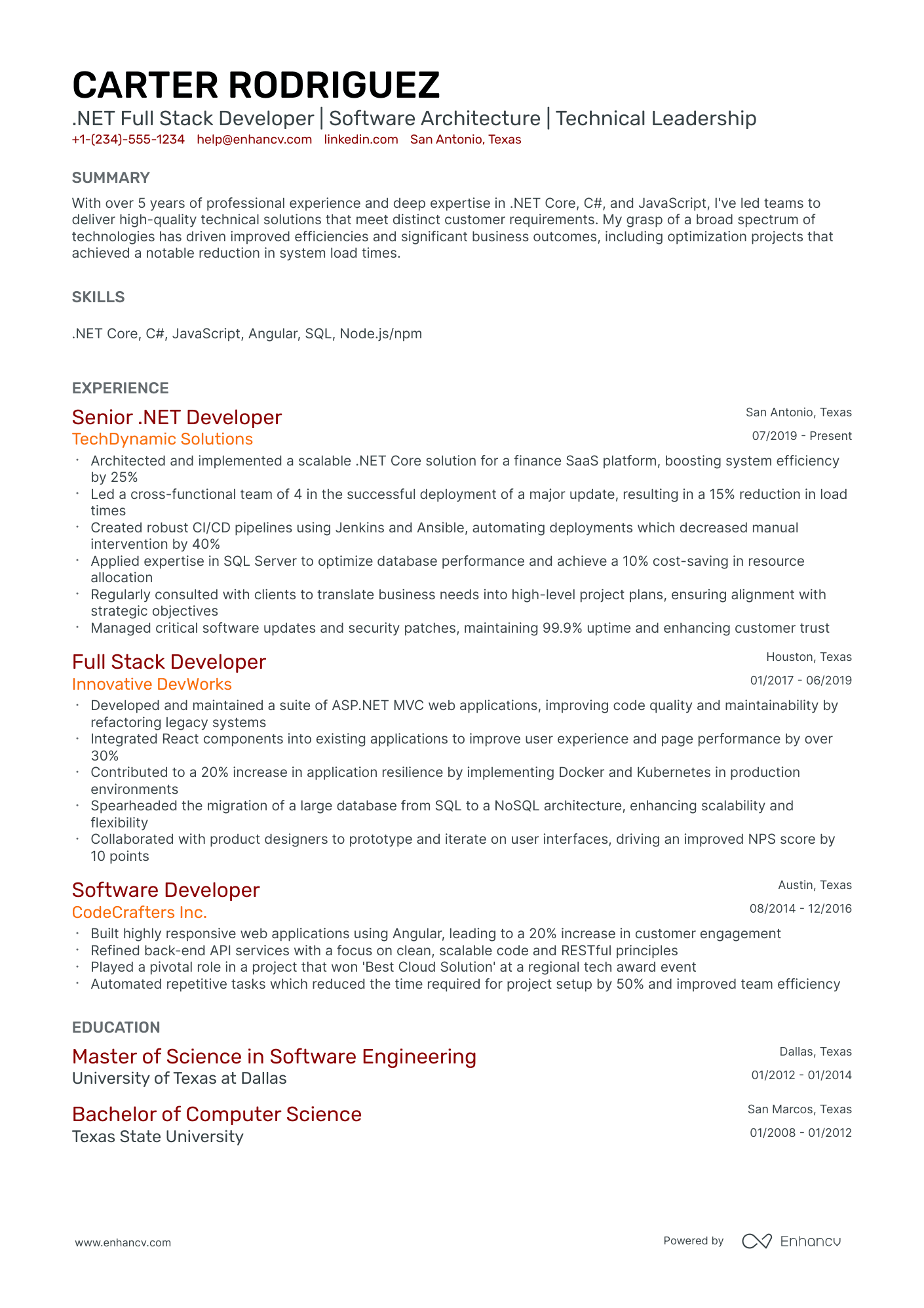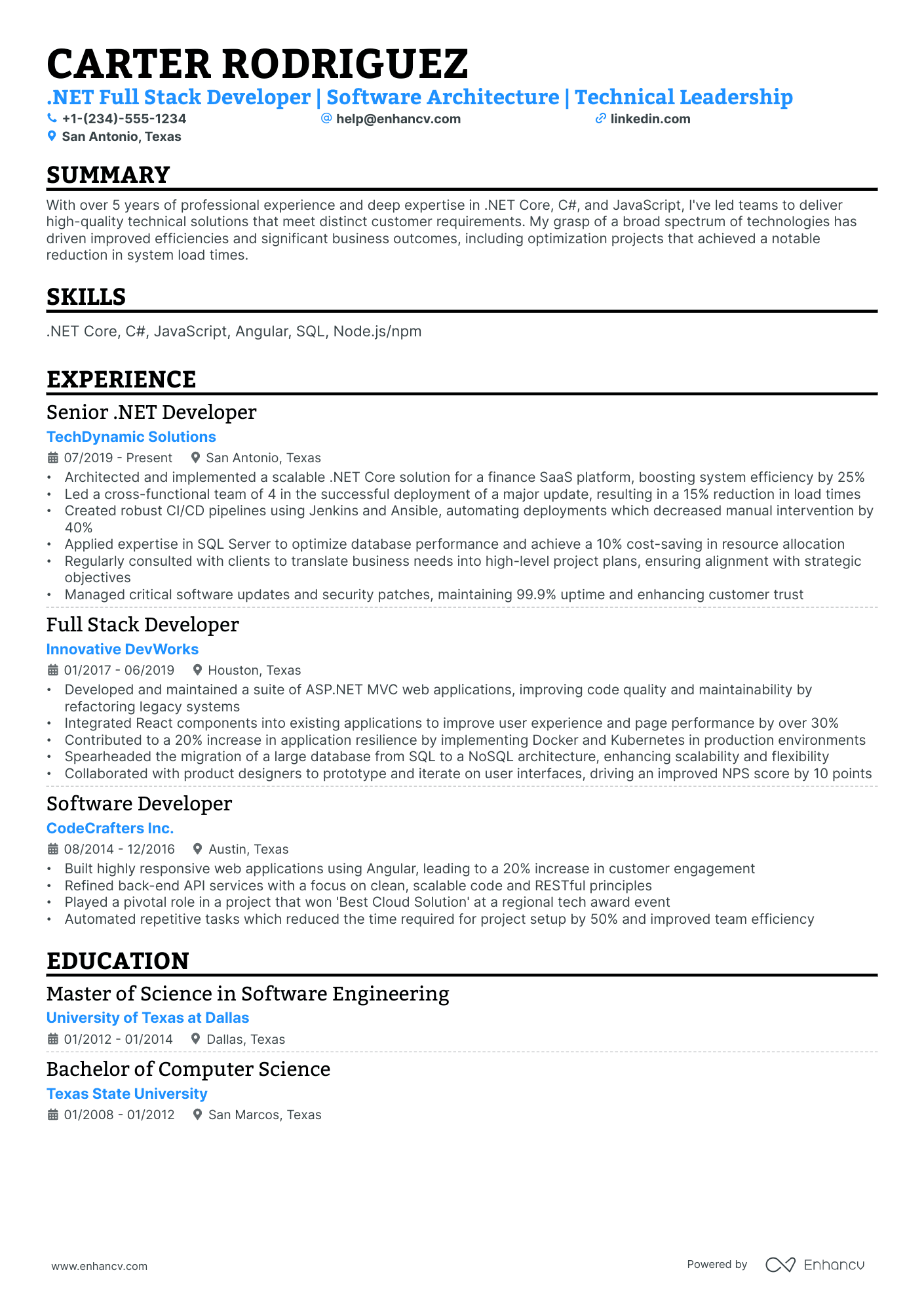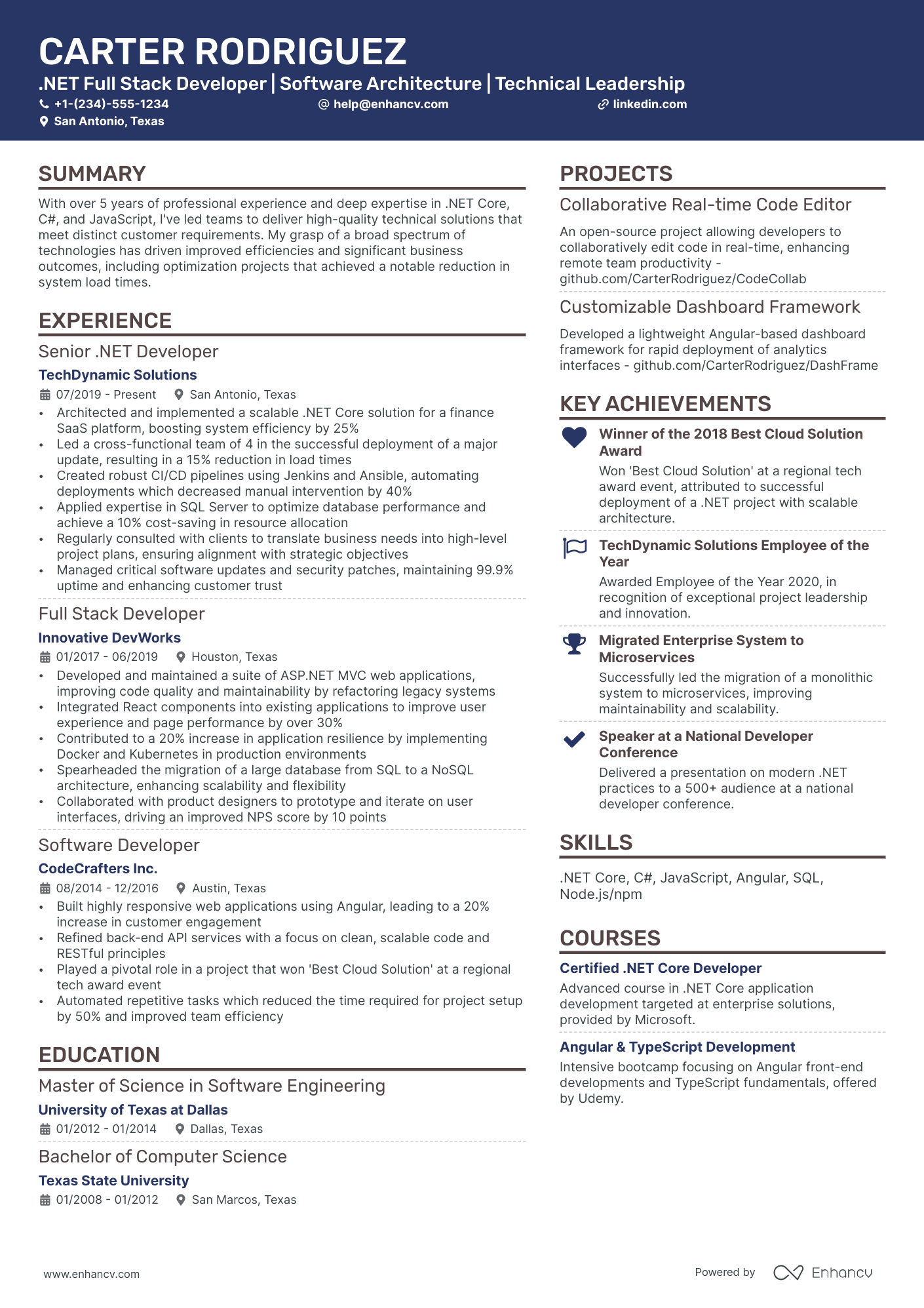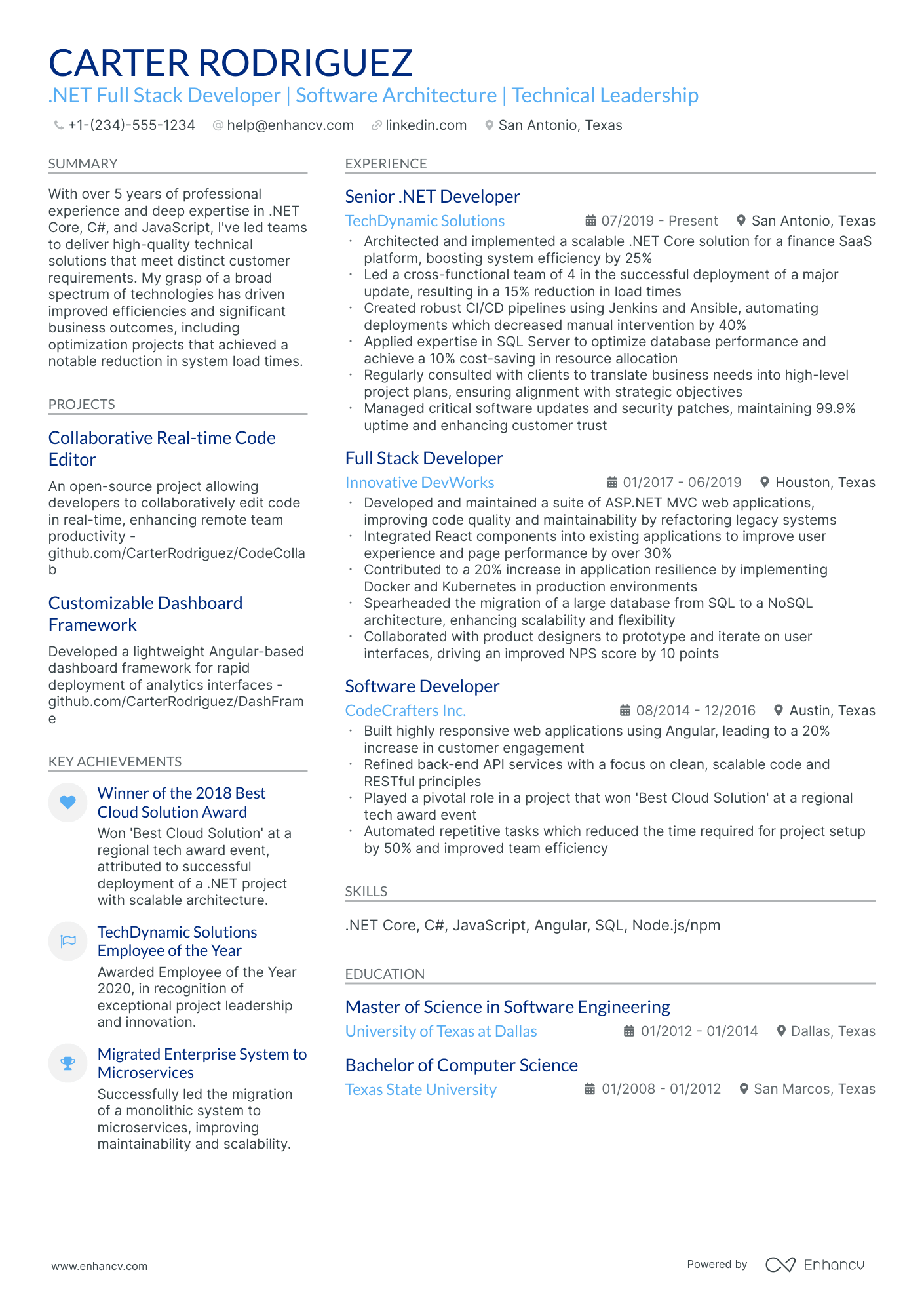One specific resume challenge you, as a .Net full-stack developer, may face is effectively showcasing your proficiency in both front-end and back-end technologies in a concise manner. Our guide will provide tailored strategies to help you highlight your full-stack skills, ensuring your resume stands out to potential employers.
- Which sections do you need to include in your resume to meet recruiters' requirements;
- How to write your .Net full-stack developer resume experience section - even if you have don't have little to no work experience;
- Real-life professional examples to guide you how to write the most important .Net full-stack developer resume sections;
- Adding even more sections so your .Net full-stack developer resume stands out with professionalism and your personality.
We've also selected some of the best (and most relevant) resume guides for the .Net full-stack developer role you're applying for:
- Technology Manager Resume Example
- Wireless Network Engineer Resume Example
- Python Full Stack Developer Resume Example
- IT Infrastructure Manager Resume Example
- F5 Network Engineer Resume Example
- Site Reliability Engineer Resume Example
- Cloud Network Engineer Resume Example
- Development Manager Resume Example
- Computer Support Specialist Resume Example
- Control Systems Engineer Resume Example
Professional .Net full-stack developer resume format advice
Achieving the most suitable resume format can at times seem like a daunting task at hand.
Which elements are most important to recruiters?
In which format should you submit your resume?
How should you list your experience?
Unless specified otherwise, here's how to achieve a professional look and feel for your resume.
- Present your experience following the reverse-chronological resume format . It showcases your most recent jobs first and can help recruiters attain a quick glance at how your career has progressed.
- The header is the must-have element for your resume. Apart from your contact details, you could also include your portfolio and a headline, that reflects on your current role or a distinguishable achievement.
- Select relevant information to the role, that should encompass no more than two pages of your resume.
- Download your resume in PDF to ensure that its formatting stays intact.
Consider your target market – resumes in Canada, for example, follow different layout conventions.
Upload & Check Your Resume
Drop your resume here or choose a file. PDF & DOCX only. Max 2MB file size.
PRO TIP
If you happen to have some basic certificates, don't invest too much of your .Net full-stack developer resume real estate in them. Instead, list them within the skills section or as part of your relevant experience. This way you'd ensure you meet all job requirements while dedicating your certificates to only the most in-demand certification across the industry.
.Net full-stack developer resume sections to answer recruiters' checklists:
- Header to help recruiters quickly allocate your contact details and have a glimpse over your most recent portfolio of work
- Summary or objective to provide an overview of your career highlights, dreams, and goals
- Experience to align with job requirements and showcase your measurable impact and accomplishments
- Skills section/-s to pinpoint your full breadth of expertise and talents as a candidate for the .Net full-stack developer role
- Education and certifications sections to potentially fill in any gaps in your experience and show your commitment to the industry
What recruiters want to see on your resume:
- Proficiency in .NET technologies such as C#, ASP.NET, .NET Core, and Entity Framework.
- Experience with front-end technologies like Angular, React, or Vue.js, alongside HTML, CSS, and JavaScript.
- Demonstrated understanding of SQL Server and database design principles specific to Microsoft environments.
- Knowledge of Azure cloud services or other cloud platforms, including deployment and CI/CD pipelines.
- A portfolio of past projects or contributions to open source that showcase full-stack capabilities within the .NET ecosystem.
What to include in the experience section of your .Net full-stack developer resume
The resume experience section is perhaps the most important element in your application as it needs to showcase how your current profile matches the job.
While it may take some time to perfect your .Net full-stack developer experience section, here are five tips to keep in mind when writing yours:
- Assess the advert to make a list of key requirements and look back on how each of your past jobs answers those;
- Don't just showcase you know a particular skill, instead, you need proof in the form of tangible results (e.g. numbers, percent, etc.);
- It's perfectly fine to leave off experience items that don't bring anything extra to your skill set or application;
- Recruiters want to understand what the particular value is of working with you, so instead of solely featuring technologies, think about including at least one bullet that's focused on your soft skills;
- Take care with wording each bullet to demonstrate what you've achieved, using a particular skill, and an action verb.
The below .Net full-stack developer resume examples can help guide you to curate your professional experience, following industry-leading tips and advice.
- Led the redesign of the e-commerce platform using ASP.NET Core, enhancing scalability and improving response times by 35%
- Integrated various payment gateways and implemented a secure, tokenized transaction process that reduced fraudulent activities by 22%
- Mentored a team of 5 junior developers, improving the overall code quality and establishing a continuous learning environment through weekly code reviews
- Developed a real-time analytics dashboard using SignalR and React, providing actionable intelligence that increased user engagement by 40%
- Spearheaded the migration of legacy systems to .NET Core, resulting in a 50% reduction in server costs and a 20% increase in performance
- Implemented CI/CD pipelines using Azure DevOps, which shortened the release cycles from a fortnight to weekly without compromising on quality
- Architected and developed a multi-tenant SaaS application serving over 100K users, which expanded the company’s market share by 15%
- Revamped the backend using microservices architecture, enhancing the maintainability and agility of the development process
- Played a key role in integrating a robust logging and error handling framework, reducing downtime by 25% and improving user satisfaction
- Collaborated in a cross-functional team to develop an award-winning mobile application, increasing customer retention by 30%
- Optimized SQL database queries, yielding a 20% improvement in application performance and reducing server load during peak hours
- Contributed to the creation of reusable UI components using Angular, accelerating front-end development by 25% for subsequent projects
- Implemented a comprehensive user permissions and role management system that improved administrative efficiency and system security
- Developed a custom content management solution for a media company that streamlined editorial processes and reduced time-to-market by two weeks
- Facilitated the adoption of unit and integration testing, which cut down bug rates by 40% over six months
- Designed and implemented a document management system using C# and AngularJS, resulting in better data organization and retrieval times for clients
- Contributed to a 10% cost saving by optimizing application resource usage and implementing caching strategies
- Led the upgrade of an ASP.NET web forms application to MVC, introducing modern design patterns and improving maintainability
- Implemented a machine learning algorithm within a .NET environment that predicted user behavior with 90% accuracy, enhancing the marketing team's efforts
- Overhauled user interface responsiveness by adopting ASP.NET MVC and Angular, which led to a 50% increase in customer satisfaction scores
- Developed and maintained APIs for cross-platform mobile applications, supporting consistent user experiences across iOS and Android devices
- Collaborated in the development of a patented financial risk management tool, instrumental in securing a leading position in the fintech industry
- Decreased application load time by 30% through performance tuning of the C# backend and JavaScript front-end components
- Implemented a strategic logging system for error tracking and user activity, significantly aiding compliance with regulatory standards
Quantifying impact on your resume
- Specify the number of users supported or impacted by the applications you developed.
- Include the percentage of efficiency increase in processes due to your optimizations or automations.
- Mention the dollar amount of revenue generated or costs saved by the software solutions you've implemented.
- State the number of projects or features you have led or contributed to significantly.
- Quantify the reduction in load times or server resources due to performance improvements you've made.
- Indicate the number of coding languages and technologies you are proficient in.
- Report the percentage of code coverage achieved through your testing protocols.
- Detail the number of team members you have mentored or supervised, if applicable.
Action verbs for your .Net full-stack developer resume
How to shift the focus from your .Net full-stack developer resume experience section to your professional profile
If you're at the start of your career journey or transitioning industries, you might be concerned about the lack of professional experience while crafting your .Net full-stack developer resume.
How can you effectively present your .Net full-stack developer resume experience section under these circumstances?
Rather than a traditional, extensive experience section, demonstrate your expertise through:
- Emphasizing your education. Your academic background might impress recruiters, especially if it includes recent, industry-relevant knowledge;
- Creating a compelling objective statement. The first few sentences of your resume should map out your motivations and career aspirations, offering insight into your goals;
- Highlighting your transferable skills. For example, if you've honed communication skills through volunteering, illustrate on your .Net full-stack developer resume how these can benefit a potential employer;
- Detailing your technical background in certifications and skills sections. As a recent graduate, your technological foundations might be particularly attractive to employers looking to develop these skills further.
It's important to remember that employers sometimes prefer candidates with less experience but who are a better cultural fit for their organization.
Recommended reads:
PRO TIP
Always remember that your .Net full-stack developer certifications can be quantified across different resume sections, like your experience, summary, or objective. For example, you could include concise details within the expertise bullets of how the specific certificate has improved your on-the-job performance.
In-demand hard skills and soft skills for your .Net full-stack developer resume
A vital element for any .Net full-stack developer resume is the presentation of your skill set.
Recruiters always take the time to assess your:
- Technological proficiency or hard skills - which software and technologies can you use and at what level?
- People/personal or soft skills - how apt are you at communicating your ideas across effectively? Are you resilient to change?
The ideal candidate presents the perfect balance of hard skills and soft skills all through the resume, but more particular within a dedicated skills section.
Building your .Net full-stack developer skills section, you should:
- List up to six skills that answer the requirements and are unique to your expertise.
- Include a soft skill (or two) that defines you as a person and professional - perhaps looking back on feedback you've received from previous managers, etc.
- Create up to two skills sections that are organized based on the types of skills you list (e.g. "technical skills", "soft skills", ".Net full-stack developer skills", etc.).
- If you happen to have technical certifications that are vital to the industry and really impressive, include their names within your skills section.
At times, it really is frustrating to think back on all the skills you possess and discover the best way to communicate them across.
We understand this challenge - that's why we've prepared two lists (of hard skills and soft skills) to help you build your next resume, quicker and more efficiently:
Top skills for your .Net full-stack developer resume:
.NET Framework
C#
ASP.NET Core
Entity Framework
SQL Server
JavaScript
HTML/CSS
Angular/React/Vue.js
RESTful APIs
Git
Problem-solving
Communication
Teamwork
Adaptability
Time management
Critical thinking
Attention to detail
Creativity
Collaboration
Self-motivation
PRO TIP
Highlight any significant extracurricular activities that demonstrate valuable skills or leadership.
.Net full-stack developer-specific certifications and education for your resume
Place emphasis on your resume education section . It can suggest a plethora of skills and experiences that are apt for the role.
- Feature only higher-level qualifications, with details about the institution and tenure.
- If your degree is in progress, state your projected graduation date.
- Think about excluding degrees that don't fit the job's context.
- Elaborate on your education if it accentuates your accomplishments in a research-driven setting.
On the other hand, showcasing your unique and applicable industry know-how can be a literal walk in the park, even if you don't have a lot of work experience.
Include your accreditation in the certification and education sections as so:
- Important industry certificates should be listed towards the top of your resume in a separate section
- If your accreditation is really noteworthy, you could include it in the top one-third of your resume following your name or in the header, summary, or objective
- Potentially include details about your certificates or degrees (within the description) to show further alignment to the role with the skills you've attained
- The more recent your professional certificate is, the more prominence it should have within your certification sections. This shows recruiters you have recent knowledge and expertise
At the end of the day, both the education and certification sections hint at the initial and continuous progress you've made in the field.
And, honestly - that's important for any company.
Below, discover some of the most recent and popular .Net full-stack developer certificates to make your resume even more prominent in the applicant pool:
The top 5 certifications for your .Net full-stack developer resume:
- Microsoft Certified: Azure Developer Associate (AZ-204) – Microsoft
- Microsoft Certified: Azure Solutions Architect Expert (AZ-305) – Microsoft
- Certified ScrumMaster (CSM) – Scrum Alliance
- Microsoft Certified: DevOps Engineer Expert (AZ-400) – Microsoft
- Microsoft Certified: .NET Core Developer (no fixed abbreviation) – Certiport / Microsoft
PRO TIP
Mention specific courses or projects that are pertinent to the job you're applying for.
Recommended reads:
Best practices to your .Net full-stack developer resume summary or objective
To start, how do you know if you should include a resume summary or a resume objective ?
- Resume summaries are ideal for .Net full-stack developer professionals with more experience, who'd like to give a quick glimpse of their biggest career achievements in the top one-third of their resumes.
- On the other hand, resume objectives serve as a road map for recruiters. Candidates use the objective to show how their experience aligns with the .Net full-stack developer role they're applying for while showcasing the North Star of their career (or where they want to be as a professional in the next couple of years).
The resume summary or resume objective could be the perfect fit for your .Net full-stack developer resume. The function of both is to highlight your professionalism succinctly. So, keep your writing specific: include no more than four sentences and target your application to the role. Here's how these specific resume sections help the .Net full-stack developer candidates stand out.
Resume summaries for a .Net full-stack developer job
- Dynamic .Net full-stack developer with 8 years of robust experience in designing, developing, and maintaining scalable applications using ASP.NET MVC, C#, and SQL Server. Proven track record of successfully spearheading end-to-end enterprise-level software solutions, resulting in a 30% increase in application efficiency for a Fortune 500 corporation.
- Accomplished software engineer transitioning to a .Net full-stack developer position, bringing forth 10 years of experience in aerospace systems and a deep passion for programming. Mastery of languages such as Python and C++, supplemented by recent intensive training in .NET, C#, and front-end technologies, eager to contribute to high-profile projects.
- Seasoned IT professional with a 12-year legacy in infrastructure management making a transition to .NET Full Stack Development. Leveraging a solid foundation in system architecture and a recent certification in .NET Core and Angular, ready to drive the development of cutting-edge web applications that enhance user experience.
- Eager to immerse in the realm of .NET Full Stack Development, I bring a fresh perspective sharpened by a dedicated completion of a comprehensive .NET bootcamp. With a strong foundation in Object-Oriented Programming and a relentless commitment to problem-solving, I aspire to integrate modern web solutions that exceed performance metrics.
- Aspiring Full Stack Developer with a tenacious drive for learning and innovation. Although new to the field, my foundational skills in C#, .NET Framework, and front-end technologies were honed through rigorous self-study and project work. Poised to contribute enthusiasm and contemporary solutions to forward-thinking web development teams.
Optimize your resume summary and objective for ATS
Drop your resume here or choose a file.
PDF & DOCX only. Max 2MB file size.
Additional valuable .Net full-stack developer resume sections to stand out
When assessing candidate applications, recruiters are often on the lookout for elements that go beyond meeting standard requirements and technical expertise.
This is where extra sections could play a key role in showcasing your unique skill set and personality.
Make sure to include sections dedicated to:
- How you spend your free time, outside of work. The interests resume section also goes to show your personality and transferrable skills; and may also serve to fill in gaps in your experience;
- Most innovative work. The projects resume section brings focus to what you're most proud of within the field;
- How you're able to overcome language barriers. The language resume section is always nice to have, especially if communication would be a big part of your future role;
- Industry-wide recognitions. Remember that the awards resume section should highlight your most noteworthy accolades and prizes.
Key takeaways
- The format and layout of your .Net full-stack developer resume should reflect on both your career and what matters most to the job you're applying for;
- Use the resume summary and objective to hint at your most prominent accomplishments;
- Always be specific about your experience and consider what value each bullet you curate adds to your .Net full-stack developer application;
- Consider how your academic background and technical capabilities could further showcase your alignment to the role;
- Your soft skills should contribute to your overall .Net full-stack developer profile - aligning your personality with skills and results.

